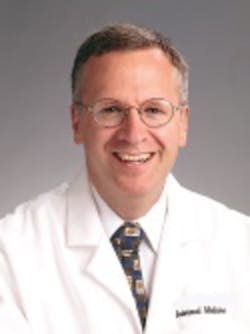As the accountable care revolution rolls forward, it is inevitable that some of the most innovative leaders of that revolution are senior executives of multispecialty medical groups. After all, it is physicians who work most closely and regularly with patients, particularly the high-risk, high-cost patients whose utilization is leading the bulk of expenditures in the current healthcare system nationwide.
One of the pioneering organizations in the accountable care organization (ACO) space is the 300-plus-physician, 17-location Crystal Run Health Care, in New York state. Founded 18 years ago, Crystal Run Health Care is based in Middletown, an hour northwest of New York City, in the Hudson Valley region. Its main service area encompasses the counties of Orange, Sullivan, and Rockland, as well as a part of Westchester County, and a small office in northern New Jersey. Two physicians on the Upper East Side of Manhattan are also Crystal Run doctors.
Crystal Run Health Care is a participant in the Medicare Shared Savings Program, and was one of the initial first-round MSSP organizations when it joined the program in April 2012.
Gregory Spencer, M.D., Crystal Run’s CMO and CMIO, was one of a number of healthcare leaders interviewed by HCI Editor-in-Chief Mark Hagland for the magazine’s July-August cover story. Below are excerpts from his interview with Hagland earlier this summer.
What made you and your colleagues decide to participate in the Medicare Shared Savings Program for ACOs?
We’ve been moving into a value-based direction for a long time. We’ve been Joint Commission-accredited as a private practice; we received an ambulatory certification; we were one of the first in the country to do so. I was the seventh doctor and second internist when I joined the practice in 1996; and we were growing very quickly, and felt that how the Joint Commission approaches safety was appropriate. In addition, we wanted to define ourselves from a marketing standpoint, and to demonstrate objective quality, so for a bunch of different reasons, we decided to become accredited.
And we early on became a patient-centered medical home. We’ve been on an electronic health record since 1999. So in sum, we’ve had a long tradition of data-driven care, and, seeing that pure fee-for-service reimbursement was not a long-term prospect, we made the decision to move in this direction [of becoming an MSSP ACO]. We were initially a finalist for Pioneer MSSP, but because of our size, they wanted bigger groups, and we felt we needed experience with claims data, and that [becoming a regular MSSP participant] was a way to do that relatively painlessly as much as you could say those words—to learn how to manage the population and learn what the data meant. And it’s been successful that way.
The setup of the program is such that you still get fee-for-service payment; and there’s a downside in that patients can go wherever they want, and it’s not a narrow network. But it’s very much worth it. And we have our application into the state of New York to create a health plan, too. We really felt that we should do something to try to cut out a middleman, to not have a shareholder entity take a large percentage of profits off the table. Instead, we’d prefer to be on the top line of that, and be able to share a bit of the savings; and we take care of patients over a long period of time, and we might as well involve the patient, and kind of do performance risk as well as insurance risk.
You’d be going directly to employers with your health plan product?
Yes, and consumers will be able to come directly to us as well. We’re going to be a narrow-network product. The majority of the care would be performed by us. And we’re going to be agnostic. I’m a doctor, I don’t look at patients.
If the state of New York approves it, when would you become a health plan?
January 2015. It would be Crystal Run Health Plan.
Everyone has shared that successful patient attribution is harder than it looks.
The attribution piece is huge, and really, every payer is slightly different, and it might seem simple, but it’s not. And what do you do with people who see a lot of urgent care but don’t really have a regular primary care physician? And by being attributed, you’re saying, well, you might get some sort of PMPM [per member per month] payment, and that’s good, but if you’re now responsible for the outcomes metrics for a patient and you don’t have a relationship with that patient and aren’t able to hit the quality gates, you’ve missed your opportunity for savings.” So, he says, it is vital to get attribution right, and to link successful attribution with successful engagement of all active patients in the ACO.
Are you using business intelligence tools in this work?
Yes, we have our own business intelligence department. We just hired two people, so I think we will have ten, but we’re eight, currently.
With regard to business intelligence, what have been the biggest challenges and learnings so far?
Well, when we started, the business intelligence work was focused more on the practice management end of the house, and that was one of the ways we were able to grow as fast as we have. The analytics was around dollars, where the patient is coming from, RVUs, etc.; over the past five years, there’s been much more clinical informatics development here. We’re doing risk stratification all the way from identifying who our patients are and where they live, all the way to what problems they have and registries, and the risk stratification piece of whether they have high-risk conditions that should be managed.
Do you have disease-specific programs?
Yes, we have disease registries and medical homes. We’re an NCQA-accredited medical home; we were the first one east of the Mississippi.
Do you primarily follow disease management or case management concepts?
We do a little bit of both, mostly through case management, but with a CHF [congestive heart failure] program. We have embedded care managers in every one of the medical homes for primary care—five or six medical homes—and we also have a case manager in our affiliated hospital as well. We have our own hospitalists.
Do you have a primary hospital affiliation?
We’re affiliated with several hospitals, but Orange Regional Medical Center in Middletown is where the care manager is.
Do you provide dashboards for the physicians?
Yes; we did mostly homegrown stuff for a long time, but because of our growing size and scope, and the sophistication that we need to keep bringing to the table, we’re working with a data warehouse company to do that piece of it to get on a more modern platform; we’re also working with our EMR vendor to do a collaborative care optimization project to bring different pieces of things into an EMR suite, so that people are in a common source of truth, so to speak.
What is your EMR?
We use NextGen.
What have been the biggest IT-specific challenges?
Well, you need data warehouse capability to do most of this stuff; you need the ability to gather information from several sources. Even if you just have clinical data, it’s better to be able to join that to claims data for a coherent set. And to do that in a data warehouse, you need a particular skill set, and that’s not that typical report-writing skill set. So you either have to hire people who know how to do that, to build or buy a data warehouse, and to maintain it. Even if you buy something already created you have to maintain it. So the skill set of data warehouse creation. And you need data warehouse people who are clinically informed.
Have you been making use of medical informaticists?
We’ve grown our BI guys in-house, but it takes a while to get people up to speed to where they’re clinically informed, and know the current questions and can get to the data faster. And you need to work with super-users, clinical liaison people. So you need IT people who are clinically informed and clinical people who are IT informed. People need to know what clinicians need and want in terms of data.
So that dialogue takes place, and it’s iterative. And there are not a lot of people out there who do this, and if there are, they’re kind of health plan-y people who are used to dealing with claims data, but not clinical data. So first, you have to get data into a place to report from somewhere, so that’s a data warehouse, and then making data clinically actionable and then just the organizing… the health plan is good for the claims. But what we can do as a medical group is, we’re not just a health plan with nurses calling patients on the phone and haranguing them, that has not worked so well over the years. So those are all the pieces, and we’re guided by groups in the Midwest and West who have been doing this for a long time.
How has it been, working with Medicare?
Medicare is good! The data is not as timely as you’d like it to be. And there are attribution problems, or they’ve released protected information by mistake and you have to destroy it, but they give you the data, at least; you at least get a full claims set.
Are there strong gains being made in the MSSP program?
Yes. The shared savings is definitely a transition state, to get people comfortable. And that was the goal all the time. The goal was not to get an endless contract of shared savings, because as you squeeze that, the delta becomes smaller and smaller over time. And you’d have zero savings eventually. But it’s been not a bad thing. We’ve gotten the basics of what we’ve hoped to get out of it. So I’m not negative about it.
Some press coverage, both in the trade press and in the mainstream media, has been very nasayer-ish, around ACO development.
You know, initially, there had been so much hype around the Medicare Shared Savings Programs for ACOs, with predictions that everybody would save gobs of money. And the concept became so popular that there are now a lot of ACOs in name only. Many people wanted to be ‘modern,’ but weren’t really at the place where they could really manage populations.
What about the fundamental culture change that has to occur among physicians and other clinicians, in terms of shifting away from a fee-for-service mentality to a care management and population health mentality?
It’s not easy to get there; you have to have the mindset of doing only what’s shown to have a positive impact on the patient—the right care and the right time, or stuff that’s shown to be useful. It means looking critically at what you’re doing and delivering just the right care, no more, no less, at the right time and in the right way, and that’s not easy.



